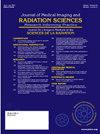使用双能量 CT 对直接密度算法重建图像中的放射治疗剂量计算进行评估
IF 1.3
Q3 RADIOLOGY, NUCLEAR MEDICINE & MEDICAL IMAGING
Journal of Medical Imaging and Radiation Sciences
Pub Date : 2024-10-01
DOI:10.1016/j.jmir.2024.101487
引用次数: 0
摘要
背景计算机断层扫描(CT)用于模拟和治疗计划过程。剂量计算基于 HU-ED 校准曲线,该曲线随管电压而变化。剂量计算使用的是标准 120 kV 的单一 HU-ED 曲线。然而,直接密度算法可以重建不同管电压下的图像,与 HU-ED 校准曲线无关。本研究旨在评估标准千伏和直接密度重建图像之间的辐射剂量。电子密度模型按照脑部、头颈部、乳腺、腹部和盆腔的方案进行扫描,扫描在所有管电压下进行,包括 70、80、100、120 和 140 千伏。在治疗计划系统中创建了标准千伏和直接密度重建的 HU-ED 曲线。然后,使用胸腔和头颈部方案对均质模型(固体水模型)和异质模型进行扫描。比较了标准千伏图像(120 千伏)和直接密度重建图像在不同管电压(包括 80、100、120 和 140 千伏)下的辐射剂量。结果表明,在同质和异质模型中,所有管电压下的剂量计算均未显示出标准千伏和直接密度重建之间的差异,P 值为 0.05。此外,在模拟过程中选择较低的能量水平可以减少患者的剂量。本文章由计算机程序翻译,如有差异,请以英文原文为准。
Evaluation of dose calculation in Direct Density algorithm reconstruction images using dual energy CT for Radiotherapy
Background
Computed tomography (CT) is used in the simulation and treatment planning process. The dose calculation is based on the HU-ED calibration curve, which varies with tube voltages. A single HU-ED curve of standard 120 kV is used for dose calculation. However, Direct Density algorithm can reconstruct images from different tube voltages, regardless of the HU-ED calibration curve. This study aims to evaluate the radiation doses between the standard kV and the Direct Density reconstruction images.
Methods
The image acquisition and data collection followed the machine protocol. Electron density phantom was scanned with Brain, Head and Neck, Breast, Abdomen and Pelvis protocol, the scanning was performed for all the tube voltages including 70, 80, 100, 120 and 140 kV. HU-ED curves from standard kV and Direct Density reconstruction were created in the treatment planning system. After that, the homogeneous phantom (Solid water phantom) and heterogeneous phantom were scanned using Thorax and Head and neck protocol. The radiation doses between the standard kV images (120 kV) and the Direct Density reconstruction images in different tube voltages including 80, 100, 120, and 140 kV were compared.
Results
The results showed that the dose calculation did not show the difference between the standard kV and the Direct Density reconstruction for all the tube voltage in homogeneous and heterogeneous phantom at p-value < 0.05.
Conclusion
The difference in the radiation dose was less than 1%, indicating that images obtained from Direct Density reconstruction can be used to calculate radiation doses in clinical practice. Moreover, the patient dose can be reduced by selecting lower energy levels in the simulation process.
求助全文
通过发布文献求助,成功后即可免费获取论文全文。
去求助
来源期刊

Journal of Medical Imaging and Radiation Sciences
RADIOLOGY, NUCLEAR MEDICINE & MEDICAL IMAGING-
CiteScore
2.30
自引率
11.10%
发文量
231
审稿时长
53 days
期刊介绍:
Journal of Medical Imaging and Radiation Sciences is the official peer-reviewed journal of the Canadian Association of Medical Radiation Technologists. This journal is published four times a year and is circulated to approximately 11,000 medical radiation technologists, libraries and radiology departments throughout Canada, the United States and overseas. The Journal publishes articles on recent research, new technology and techniques, professional practices, technologists viewpoints as well as relevant book reviews.
 求助内容:
求助内容: 应助结果提醒方式:
应助结果提醒方式:


